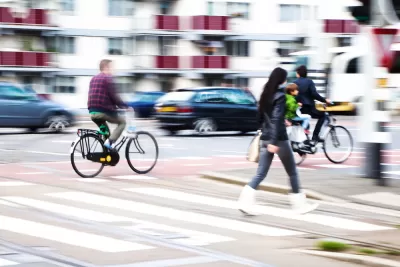New data shows continued growth in pedestrian road deaths in most U.S. states.

Pedestrian deaths rose by 5 percent in the first half of 2022, according to newly released preliminary projections from the Governors Highway Safety Association (GHSA). “This deeply troubling projection follows a 40-year high in pedestrian deaths in 2021 and continues a gruesome decade-long trend of more people dying while walking on U.S. roads,” the GHSA said in a press release.
A combination of factors, including a surge in dangerous driving that began at the start of the pandemic and has not lessened; larger, heavier vehicles that are more likely to seriously injure or kill people on foot in the event of a crash; roads designed to prioritize fast-moving traffic over slower speeds that are safer for pedestrians; and inadequate infrastructure such as sidewalks, crosswalks and lighting in many parts of the country.
The GHSA notes that “three states – California, Florida and Texas – accounted for 38% of all pedestrian deaths in the first six months of 2022 but are home to 28% of the U.S. population.”
An article by Daniel C. Vock in Route Fifty adds that “Florida saw the highest increase in the number of deaths, with 29 more than in the previous year.” On the positive side, “Twenty-one states and the District of Columbia saw decreases between the two years, but only two states (Kansas and Nevada) saw two straight years of declines.”
The GHSA asserts its support for the Safe System approach to transportation planning, which outlines tools for improving pedestrian safety and protecting road users outside of cars. Vock notes that, despite the USDOT’s campaign to promote Safe System, it will take some time for any federal actions to have an impact on local trends.
FULL STORY: New Projection: U.S. Pedestrian Deaths Rise Yet Again in First Half of 2022

Alabama: Trump Terminates Settlements for Black Communities Harmed By Raw Sewage
Trump deemed the landmark civil rights agreement “illegal DEI and environmental justice policy.”

Study: Maui’s Plan to Convert Vacation Rentals to Long-Term Housing Could Cause Nearly $1 Billion Economic Loss
The plan would reduce visitor accommodation by 25% resulting in 1,900 jobs lost.

Why Should We Subsidize Public Transportation?
Many public transit agencies face financial stress due to rising costs, declining fare revenue, and declining subsidies. Transit advocates must provide a strong business case for increasing public transit funding.

Wind Energy on the Rise Despite Federal Policy Reversal
The Trump administration is revoking federal support for renewable energy, but demand for new projects continues unabated.

Passengers Flock to Caltrain After Electrification
The new electric trains are running faster and more reliably, leading to strong ridership growth on the Bay Area rail system.

Texas Churches Rally Behind ‘Yes in God’s Back Yard’ Legislation
Religious leaders want the state to reduce zoning regulations to streamline leasing church-owned land to housing developers.
Urban Design for Planners 1: Software Tools
This six-course series explores essential urban design concepts using open source software and equips planners with the tools they need to participate fully in the urban design process.
Planning for Universal Design
Learn the tools for implementing Universal Design in planning regulations.
Caltrans
Smith Gee Studio
Institute for Housing and Urban Development Studies (IHS)
City of Grandview
Harvard GSD Executive Education
Toledo-Lucas County Plan Commissions
Salt Lake City
NYU Wagner Graduate School of Public Service





























